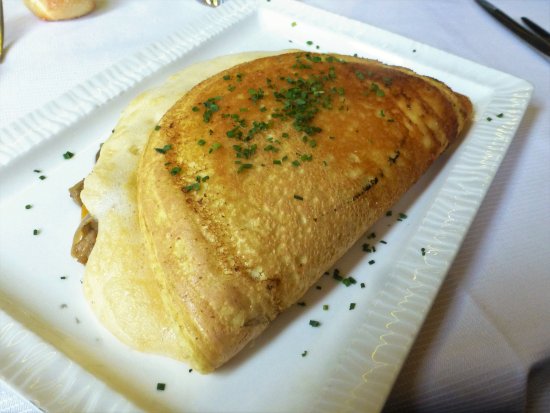#French #omelet #eggs #butter
“The difference between an excellent omelet and a good omelette is big.” –Paul Ebeling
When it comes to the proper technique for a truly great French omelette, there are 2 major schools of thought. The most traditional is the rolled omelette, a dish that is served “nicely rolled, and with the ends nicely folded.
I prefer a folded omelette over this classic rolled delicacy, a version of the dish perhaps best demonstrated by La Mère Poulard. The Mont-Saint-Michel restaurant has been serving these puffy omelette, the house signature, since the late 1800’s.
While the precise recipe is guarded, 1 part of the mystery is evident to anyone who walks by to see omelettiers cooking them up in long-handled copper pots: the open fire.
Cedric Navet, Chef de Cuisine at La Mère Poulard, explains that the omelette pictured above is cooked over this very hot flame on just one side until puffy but barely set, folding it only at the last minute, as it’s being plated.
“You cannot roll it,” he explains. “You would break all of the unctuosity. It would fall and become completely flat.”
“Someone cooking at home would have a hard time making our omelette, because we really get that flavor of the open fire,” cautions Chef Navet. He notes, nevertheless, that it would be possible to get a similar texture by toying with the temperature.
“You start out very hot, and finish very low,” he says. “You really need to make a crust from the get-go.”
To get this texture at home, start your omelette out in a very hot pan, and watch it closely. After a few mins, a few bubbles will begin to form, emerging from the foam.
After 3 or 4 mins you know that the crust is at the right temperature and cooked properly.
From there, turn down the heat and allow the omelette to set, sliding it out of the pan and folding it onto the serving plate.
Omelettes in France are rarely filled with lots of ingredients like American diner omelets are, and for good reason: properly executed technique should be allowed to do all the talking.
I prefers my omelettes plain, with “just a little bit of fleur de sel and a little butter.” If when I do fill my omelette, I chooses simple fillings like fine herbs or mushrooms and truffle.
At La Mère Poulard, while the menu offers several “fillings” including ratatouille, ementhaler, and/or jambon, “topping” would perhaps be a more a propos term. But the flavor of the omelette remains the same, whether there’s a filling or not.
To truly let the simplicity of the omelette shine, it is Key to start with only the best ingredients.
The secret to everything French is always the quality of the ingredients married with the appropriate gest to amplify the best quality of ingredient. This means, first and foremost, high-quality butter and eggs.
When it comes to flavor, the eggs have to be the best.
Eat healthy, Be healthy, Live lively









